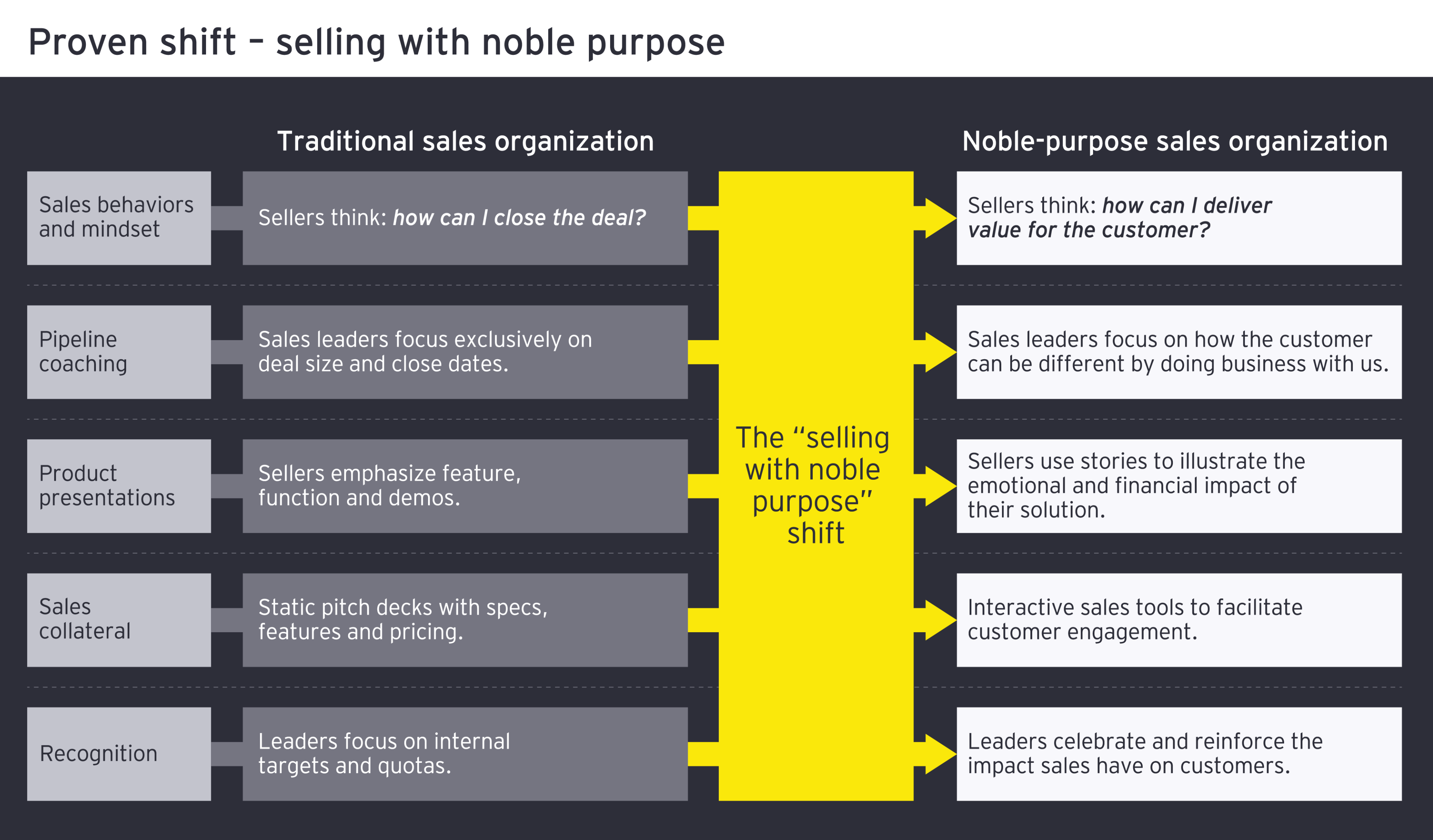
Chapter 1
Redefining sales in a COVID-19 impacted world
Finding a higher purpose than driving revenue can help you win the market.
Business norms are changing in real time and the implications for sales teams loom large. Beyond the obvious changes — the shift to remote work and video sales calls — the COVID-19 crisis has reframed the relationship between buyers and sellers.
As the collective population asks deeper questions (such as who we are and why we here), customers are applying a similar self-reflective lens to their work and interactions with salespeople. Customers are asking: who is really here to help me?
We stand in a place and time where brand reputations are being quickly won (and quickly lost) based on the market’s perception of the organization’s intent. One sales leader summed up the challenge, saying, “I need my salespeople to be seen as helpful rather than scavengers.”
This poses a quagmire for sales leaders as they are under pressure to produce revenue. When sales targets loom large, the traditional response is to double down on what has worked in the past. The organizational narrative becomes “sell, sell, sell,” with sales managers emphasizing revenue goals, pushing salespeople to get deals over the line and often dangling financial incentives to spur action. The problem with this traditional approach is that it creates an inwardly focused sales team that is more likely to be off-putting than engaging to customers.
To avoid this problem, sales leaders, who need to drive revenue, can point their teams toward a higher purpose bigger than money. And, they can direct them to something more meaningful than quarterly sales targets. The sales teams that win the market post-COVID-19 will be from the organizations that decide their noble purpose is to improve life for their customers.
Sales leaders wanting to drive revenue must focus their teams on a higher purpose than money. They can direct them to something more meaningful than quarterly sales targets. In the post COVID-19 market, the sales teams that will win are those that have decided upon their noble purpose to improve the lives of their customers.

Chapter 2
Selling with graciousness, trust and noble purpose
Providing a new path forward can help foster personal resilience.
When viewed through the eyes of the customer, the traditional quota-focused approach to driving sales growth provides little value. A sales team with traditional motivations like “hit the number” see their customers as objects. Customers quickly become money to be gained rather than people and businesses to be helped.
The better path forward
Lisa McLeod, the author of Selling with Noble Purpose, affirms, “Our research reveals that salespeople who sell with noble purpose, who genuinely understand how they can make a difference to customers, outsell salespeople focused on internal targets and quotas.”
Telling a sales team to “focus on the customers” is a decent start. To be truly relevant, an even more specific shift in mindset is required. Selling with noble purpose goes beyond traditional customer centricity. It is about more than simply pleasing customers; it is about improving the customer’s condition and aligning the entire sales organization toward that purpose. To be successful, customer impact must become as prominent in the organizational narrative as sales targets.
McLeod says, “In a post-COVID-19 world, we’re seeing first-hand evidence that noble purpose sales teams are deemed more essential than transactional sales teams. They’re getting better access at higher levels because customers trust them — they know the sales team’s purpose is to improve their business. Sales teams that operate with a noble purpose are also more resilient than traditional sales teams. They persist — and as a result — become more resilient, because they care about their customers more than the sale.”
A commercial bank CEO who implemented Selling with Noble Purpose in 2019, says, “When your people know at a very deep level that their noble purpose is to help customers, they become galvanized.” This particular commercial sales team won new business while other banks were floundering.
When your people know at a very deep level that their noble purpose is to help customers, they become galvanized.
Purpose has become an important tenet in business, yet the COVID-19 crisis demonstrates there’s often a disconnect between an organization’s aspirational purpose (make a difference to customers) vs. what gets emphasized on a daily basis in sales (hit the number).
In an earlier research study conducted by EY titled, Is Your Purpose Lectured or Lived?, it was revealed that as purpose cascades down an organization, employees lose the sense of purpose that many of their bosses claim to be pursuing. The belief that purpose is a strategy, and decision-making tools fall by as much as 50% by the time it gets to the vice president (VP) level. Working virtually has only exaggerated that disconnect. McLeod says, “In our decade of work with sales teams, it’s clear that when leadership fails to infuse a customer-driven purpose into the daily cadence of sales, the sales team runs the risk of becoming transactional, and being deemed self-serving or irrelevant by customers.”
Sales organizations that can align themselves around the noble cause of customers will emerge as trusted advisors. What’s changed in the post-COVID-19 world is that buyers now expect this to be more than mere sales techniques, they expect it to be part of a sales organization’s DNA.
The difference between sales organizations who thrive and those that falter will be found by looking beyond the quantitative metrics that sales teams traditionally have been using to measure performance.
The secret for winning hearts and minds is more qualitative than quantitative. And this secret lies within the sales meeting’s agendas. It is in the way leaders provide coaching and in the data they track in their customer relationship management (CRM) tool. It shows up in the formats they use for call planning and the post-call debriefs. And it’s the basis for stories that sales professionals tell each other and their customers.
These seemingly small elements within the organization are the places where purpose can be activated. These interactions and systems will point a sales team in one of two directions. They either point sales team internally, toward their own sales targets, or they will point the sales team toward their noble purpose, ensuring that they look externally toward the impact they have on customers.
A sales team that is inspired and aligned around the graciousness, trust and noble purpose of making a difference to customers is a force with which to be reckoned.
The secret for winning hearts and minds lies within the sales meeting’s agendas. It shows up in the formats sales leaders use for call planning and the post-call debriefs. And it’s the basis for stories that sales professionals tell each other and their customers. These seemingly small elements are the places where purpose can be activated.
Fostering personal resilience
Salespeople who define themselves solely by their ability to hit sales targets will experience many highs and lows. In a volatile market, when sales may be slow, salespeople with no bigger purpose than to hit the number are more likely to succumb to fear and anxiety, which is hardly the right mindset for being engaging with customers. In fact, when we find ourselves in a “threat” state, our brain’s ability to reason and make sound decisions becomes impaired.
A salesperson who has a constancy of purpose has more confidence and tenacity. When your noble purpose is to improve life for customers, there is always opportunity. As one CEO put it, “In a world of uncertainty, our noble purpose gives our team something concrete. It’s something we can tether ourselves in the face of setbacks and uncertainty.”
It’s long been assumed that sales teams are primarily driven by economic incentives. A growing body of evidence tells us this traditional financial approach to sales motivation is backward. Dr. Valerie Good, a professor and researcher at Michigan State University, reports that her study revealed that salespeople are more likely to work harder and be more adaptable if they’re motivated by the belief that one is making a contribution to a cause greater, and more enduring, than oneself, as compared to a desire for money.
These findings are crucial for leaders who need to rally their team in a challenging market. In a post-COVID-19 world, people are searching for meaning and questioning their relationship with work. A sense of noble purpose binds a team together and gives them the tenacity and resilience to tackle big challenges.
Mary Slaughter, Executive Director, People Advisory Services, Ernst & Young LLP, believes that one of the outcomes of COVID-19’s social isolation is the profound awareness of our need for human interaction. “In the fields of behavioral psychology and neuroscience, the overwhelming research validates the social nature of our brains. We are literally wired to make social connections with one another. Our need for human-to-human interaction is a necessity rather than a nicety. When it’s missing, we experience emotional pain and suffering, which interestingly travels over the same neural networks as physical pain. Our humanity is biological and must be integrated into all we do.”
Mary continues, “In the context of sales, those who nurture meaningful interactions with their clients are creating the basis for long-lasting relationships. Connecting on a human level with clients can support their sense of safety and well-being and encourage transparency in return. One of the great lessons that will be learned from this global pandemic is that our humanity must be acknowledged. For sellers, their humanity is defined, in part, by the way they view and interact with their clients. How sellers ‘show up’ now will be a pivotal moment in their personal brand for years to come.”
A sales team emboldened to improve life for customers has the fierce urgency of now. They are resilient and innovative, collectively and individually, because they know customers are counting on them.
Jeffrey Stier, Executive Director, People Advisory Services, Ernst & Young LLP, explains selling with noble purpose means that every salesperson has the skills and training to connect the three dots of purpose with each other, which are:
- Their personal purpose
- The purpose of their sales organization
- The purpose of the individual customer
When a salesperson lives their personal purpose every day, they have greater presence, courage and confidence.
If that salesperson can then connect their personal purpose to the purpose of their sales organization, they begin to feel differently about their work. They feel they are contributing to something bigger than themselves.
Finally, if that salesperson can help a customer understand how their relationship will positively impact and advance the customer’s personal purpose and agenda, something magical happens. Research suggests that on average the salesperson will be:
- 64% more fulfilled
- 50% more likely to have meaningful work and client relationships
- 225% more productive
- 32% healthier
- 50% more likely to take on leadership roles
Impact of helping a customer’s personal agenda
225%More productivity, on average, from the salesperson.
Impact of advancing a customer’s personal purpose
50%More likely, on average, for the salesperson to take on leadership roles.
Stier continues, “Selling with noble purpose is personal. It catalyzes salespeople to come fully alive. This clarity creates a rare breed of sellers who show up with heart and soul, and put every ounce of their effort into driving results for their organization and its customers.”

Chapter 3
How to inspire sales teams to jump-start with a sense of urgency
Four things leaders can do right now to activate a sense of graciousness, trust and noble purpose.
1. Align the sales team around clear customer impact
Articulating examples of how your organization makes a difference to customers shift the organizational narrative from an inward focus on sales targets to an outward focus on the people who drive revenue — your customers. This seemingly “soft” departure from the traditional sales leadership language of win rates and deal size may feel counterintuitive at first. It’s worth remembering that the internal conversation becomes the external conversation. As one sales manager says, “If all you do is talk about your numbers, that’s what your salespeople will be thinking about when talking with customers. It’s hardly a compelling story.”
Wharton Professor, psychologist and author Adam Grant’s now-famous 2007 study, Impact and the Art of Motivation Maintenance, proved that even a short story about emotional impact improves sales performance. When call center employees (whose job was to solicit donations) had a five-minute interaction with scholarship students to see the impact of donation, they spent more than two times as many minutes on the phone and brought in vastly more business – a whopping 171% increase.
Improved sales performance driven by emotional investment
171%Increase in business brought in by call center employees following a better understanding the impact of the donations they bring in.
Being clear about customer impact requires going beyond the general benefits found in a typical value proposition. It’s more specific and emotive. For example, ask yourself:
- How does our solution impact a client’s job and life for the better?
- When we do our job well, how does that help them in other areas?
- What’s the ripple effect on their families and their organizations?
Go even deeper to reveal how you might be (for instance):
- Saving customers time, so they can focus on their families
- Helping customers better leverage data, enabling them to make more informed strategic decisions to drive their business goals
- Increasing customers’ profitability, enabling them to keep their business running and invest for growth
Elizabeth Lotardo, co-author of Selling with Noble Purpose, reports, “Individual salespeople are in search of connection and meaning. They want to feel like they are a part of something and like they’re contributing to a cause greater than themselves.” Customer impact stories tell your sales team: the work we do here matters.
Individual salespeople are in search of connection and meaning. They want to feel like they are a part of something and like they’re contributing to a cause greater than themselves.
2. Shift the sales ecosystem toward customers
The systems, processes and messages surrounding your sellers, shape their beliefs and their behaviors. In transactional organizations, the ecosystem points inward: When will the deal close? What’s the revenue, and what product are we selling them?
McLeod asserts, “A sales ecosystem animated by purpose is organized to answer a single driving question: how will the customer be better as a result of doing business with us?”
A sales ecosystem animated by purpose is organized to answer a single driving question: how will the customer be better as a result of doing business with us?
To create a more compelling sales team, leaders must shift the traditional sales ecosystem. And they must align what the CRM system tracks, what gets rewarded, how meetings are run, the type of customer intelligence salespeople capture, as well as the way sales presentations are structured. Leaders might ask: is the sales ecosystem focused on internal metrics or customer impact?
EY Americas Consulting Sales and Service Customer Principal Brian Goonan says, “Your sales process must be aligned around the way your customer buys, rather than the way you want to sell. Your CRM tool and other systems must be improving seller or customer interactions while also tracking them.”
“If you want sales behaviors to persist, then the sales ecosystem must be in sync with the behaviors you value. In social science, it’s referred to as coherence — when all the pieces make sense together. The human brain strongly prefers certainty, which means the skills we train, the coaching we provide, and the outcomes we measure and reward, must all be ‘coherent’ to accelerate seller success.”
In addition to tracking pipeline activity and sales targets, leaders can ask sales teams to capture the customer’s most important strategic initiatives and codify the pain of their current challenges. When managers talk about deals in play, they can go deeper than revenue targets and close dates. They can ask a salesperson: how will the customer be better if we close this opportunity? A salesperson who can answer that question will have more urgency for getting in front of customers and will have a better story to share.
Managers can go deeper than talking about revenue targets and close dates. They can ask a salesperson: how will the customer be better if we close this opportunity? If a salesperson can answer this question, they will instinctively have more urgency for getting in front of customers and a better story to share.
3. Reframe customer interactions to build trusted relationships
The virtual COVID-19 environment has revealed motive and intent more quickly than traditional in-person meetings because it strips away social niceties. A VP of HR describes recent meetings with sales consultants saying, “What was once tolerable in a meeting is unbearable on a video call.”
Customers refuse to sit through lengthy product presentations or self-serving discovery calls. Instead, salespeople must make themselves immediately relevant. That means throwing away the traditional pitch deck and, instead, being aligned to the client’s agenda. It means sellers must be trained on how to discover and put the customer’s perspective first and approach the entire interaction from their perspective.
EY Americas Consulting Digital Transformation wavespace Leader Woody Driggs notes, “If you build the trust, the work will come. This is a different mindset than the traditional thinking that says if you respond well to the request for proposal (RFP), the work will come. And it’s a key mindset shift we have to make to build trust.” When a company is trustworthy, customers become evangelists willing to advocate for the brand in ways more powerful than any marketing campaign.
Leaders must resist the temptation toward generic product pitches. Driggs observes, “The complexity of solutions people sell continues to increase; we are well beyond a ‘features and functions’ sale. This means a more complex sales process with more senior leadership involvement. If there is an absence of trust at the senior level, if they perceive that your team is overly focused on your pitch, you’ll be shut out.”
If trusted relationships are part of the DNA of successful sales organizations, how do you build them?
- One insight, one interaction, one experience at a time – do it again, and again and again until the sum of the interactions and the totality of the experiences lead to trusted relationships.
- Spend as much time, money and discipline building trusted relationships as you do on new products and services.
- Transform your sales organization company into a trusted customer partner — one that knows that every customer interaction is an opportunity to build or erode trust.
- Listen and respond better to every customer, on every channel.
- Ground every customer interaction and every customer experience, in purpose, graciousness, integrity, transparency and authenticity.
- Cultivate meaningful customer connections.
A successful sales organization’s competitive advantage is more than just a product, price or feature. It is a purposeful, trusted relationship — one that is difficult for competitors to copy and impossible to steal.
Salespeople must throw away the traditional pitch deck and, instead, align to the client’s agenda. Sellers must be trained on how to discover and put the customer’s perspective first. When a company is trustworthy, customers become evangelists willing to advocate for the brand in ways more powerful than any marketing campaign.
4. Train sales leaders to become “belief igniters”
Managers are the daily voice in the ear of your sales team. When faced with the disconnect between senior leadership’s purpose (which is to make a difference to customers) and sales management’s daily message (which is to hit the number) sales teams will default to their muscle memory.
Most sales managers have been trained to drive sales behavior through a quota-based reward system rather than one that is based on purpose and client impact. To rectify this, frontline sales leaders must be charged with and trained in the art of igniting and inspiring belief.
When sales managers make a daily practice of pointing to how the firm makes a difference to customers, when they share customer impact in sales meetings and when they frame new offerings in the service of improving life and business for customers, they are telling their team: this is why we exist.
Igniting belief requires more time than the traditional quantitative shortcuts sales managers use to monitor performance. And at the same time, the payoffs can be large. When frontline managers build belief in the noble cause of customers, they change their own internal story, which, in turn, impacts the way they engage and tell stories to their customers.
Instead of thinking of themselves as money chasers, salespeople start to think of themselves as people who make a difference to customers. This translates into more engaging sales behavior. Sellers who understand that their work has a lasting impact, ask more strategic questions. They design more creative solutions and they connect with customers in a more authentic way.
When frontline managers build belief in the noble cause of customers, they change their own internal story. This then impacts on the way they engage with their customers. Sellers who understand their work has a lasting impact, ask more strategic questions. They design more creative solutions and connect with customers in a more authentic way.

Chapter 4
Creating a "from/to" shift transforms the sales process
When leaders commit to selling with noble purpose, customers feel the difference, and it transforms the entire sales process.
When leaders commit to selling with noble purpose, customers feel the difference, and it transforms the entire sales process.

It’s ironic that the sales teams with a purpose bigger than money, wind up making more money. They create more lasting, trusted relationships with customers, they become differentiated in the marketplace and they stay more emotionally engaged in their jobs.

Chapter 5
The freedom to make money and make a difference
Achieving the goal of becoming more relevant, resilient and revenue generating.
The internal conversation becomes the external conversation. If you treat your customers like a number, they’ll respond in kind. You’ll quickly become commoditized, and your sales team will struggle to stay relevant.
There is a better way forward.
As leaders approach the sales challenge ahead, there is a clear choice: organizations will default to the traditional, inwardly focused mindset, or they will choose to step into a more powerful model of selling. When leaders decide that their noble purpose is to improve the lives of customers, they transform their organizations.
Selling with graciousness, trust and noble purpose takes more strategic discipline and requires more emotional intelligence — and it yields greater results for everyone, customers and sales teams alike.
Leaders now have the freedom to make money and, at the same time, make a difference. Selling with graciousness, trust and noble purpose ensures this.
Lisa McLeod, author of Selling with Noble Purpose, contributed to the development of this article
Summary
This article explores the art and science of selling with graciousness, trust and noble purpose — a philosophy and methodology for winning the hearts and minds of customers by building trusted relationships and creating long-term shared value. This approach takes more strategic discipline and requires more emotional intelligence — but it yields greater results for everyone, customers and sales teams alike.


